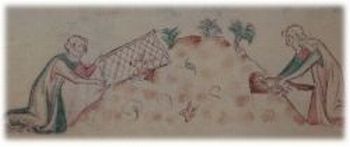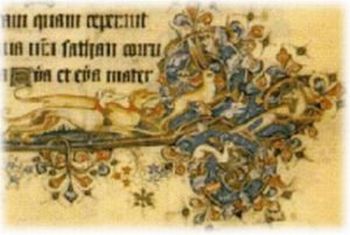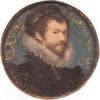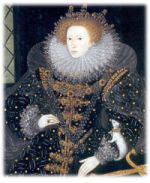Queen Mary’s Psalter, 14th Century AD
A Psalter is a collection of psalms for devotional or liturgical use during the Middle Ages.
Many psalters had fabulous drawings and this one has a illustration of women ferreting, where they netted rabbits then knocked them over with sticks.

Who knows .. perhaps those medieval maidens were members of the first ferret society! 
Sherborne Missal, 15 Century AD
The Sherborne Missal is an early 15th-century manuscript, and is said to be the largest and most lavishly decorated English medieval service book to survive from the Middle Ages.
A missal is a book containing the text, and occasionally the music, needed to celebrate Mass and every priest needed one in order to perform the ceremony. The contents of the manuscript show that it was made for St Mary’s Abbey at Sherborne in Dorset, which is in south-west England
The patron was apparently the abbot of Sherborne, Robert Bruyning and it says that the name of the main scribe was, “John Whas, the monk, laboured on the writing of this book, and his body was much debilitated by early rising.” The chief illuminator was John Siferwas and he had a team of 4 artists helping him.
The Missal, which weighs in at 20kg, is worth 15 million pounds sterling.

Have a look at the picture – looks like medieval ferreting to me. You can see the dogs going after the hare and below, there are a couple of ferrets looking verrrrry interested!
The Statutes of King’s College, Cambridge, 1443 AD
I came across The Statutes of King’s College which dated back to 1443 and which were included in a book called Ancient Laws of…King’s College Cambridge and Eton College (London, 1850).

Amongst other rules, the ones in Chapter 25 state that “… no scholar, fellow, chaplain, or clerk, or other servant of the King’s College shall keep or have dogs, hunting or fishing nets, ferrets, hawks, or falcons, nor keep in King’s College any monkey, bear, fox, stag, hind, doe, or badger, or any other wild animal or strange bird …”
What a party pooper of a university!
The Bard and his Ferrets, 1564-1616 AD
 William Shakespeare, who was born in Stratford-upon-Avon in 1564, was around during the reigns of both Elizabeth I and James I, and was a favorite of both monarchs.
William Shakespeare, who was born in Stratford-upon-Avon in 1564, was around during the reigns of both Elizabeth I and James I, and was a favorite of both monarchs.
He is without a doubt the most famous literary figure of that time and several of his plays have references to mustelids sprinkled through them! But while there were a number of plays which had references to other mustelids in them, there were only two which mentioned ferrets.
In the play of the same name, Julius Caesar has Brutus stating that “… Cicero looks with such ferret and such fiery eyes”; while in The Life of King Henry V, Pistol says “I’ll fer him, and firk him, and ferret him.”
I confess to being at a loss as to what ‘fer him, firk him and ferret him’ would refer to. Sounds pretty rude to me. 
 Nicholas Hilliard was the son of a goldsmith and he not only became a goldsmith himself but was also a limner (miniature painter). In 1570 he was appointed Court Miniaturist for Queen Elizabeth I.
Nicholas Hilliard was the son of a goldsmith and he not only became a goldsmith himself but was also a limner (miniature painter). In 1570 he was appointed Court Miniaturist for Queen Elizabeth I.
He also invented special techniques for painting jewels.
He’d put a raised drop of white paint on his pearls with some shadowing to one side, then topped it with a bit of real silver which was then burnished “with a pretty little tooth of some ferret or stoat or other wild little beast”, as recorded in his own treatise.

He painted the portrait of Queen Elizabeth I with the ermine on her arm in 1585.
Why an ermine?
The ermine was prized for its tail, which was pure white with a black tip. According to legend, the ermine would rather die than soil its pure white coat so it came to stand for purity. And as wearing ermine was restricted to royalty and high nobility, it also came to be seen as a status symbol.
Return from Ferrets in Medieval England to All About Ferrets

Deprecated: str_contains(): Passing null to parameter #1 ($haystack) of type string is deprecated in /home4/kitchast/public_html/wp-includes/comment-template.php on line 2681